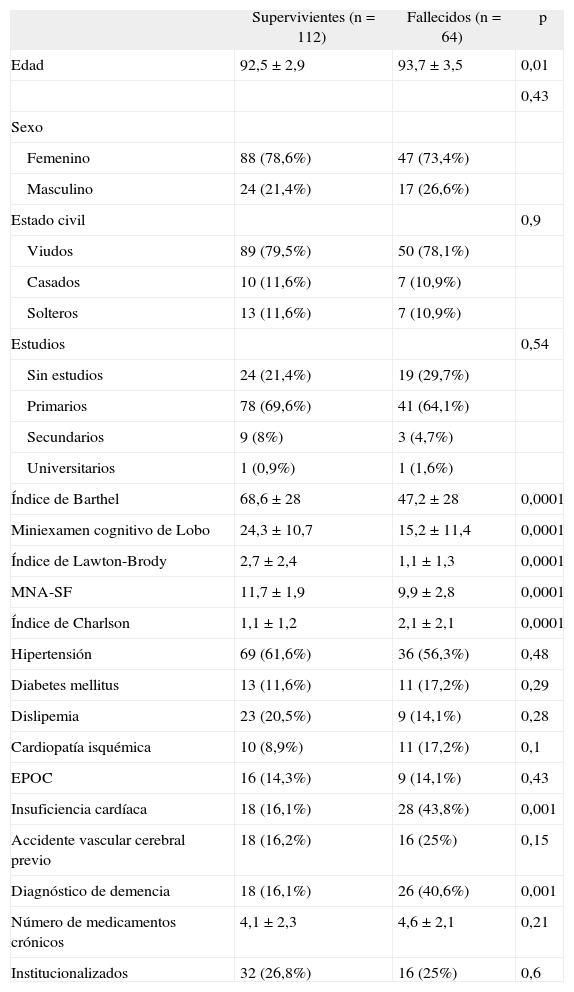Pocos estudios han evaluado los factores predictores de mortalidad en las personas muy ancianas. El objetivo del presente estudio fue evaluar qué factores podían predecir la muerte en pacientes nonagenarios después de dos años de seguimiento.
Pacientes y métodoSe evaluaron 176 nonagenarios, de los que el 73% vivían en su domicilio y el resto en residencia. Se recogieron datos sociodemográficos, la capacidad para realizar actividades básicas con el índice de Barthel (IB) y para instrumentales con el índice de Lawton (IL). Se valoró la cognición con el miniexamen cognitivo de Lobo (MEC) y la comorbilidad con el índice de Charlson.
ResultadosSe trataba de 135 mujeres (76,3%) y 41 varones, con una edad media de 93±3 años. La media del IB fue 60,8±30, la del IL 2,1±2,2, la del MEC 21±11 y la del índice de Charlson 1,4±1,7. Sesenta y cuatro pacientes habían fallecido a los dos años de seguimiento (36,3%). El índice de Charlson (OR: 1,370; IC 95%: 1,113-1,686; p<0,003), IL (OR: 0,750; IC 95%: 0,586-0,960; p<0,02) y MEC (OR: 0,964; IC 95%: 0,932-0,997; p<0,003), resultaron factores independientes de mortalidad a los 2 años de seguimiento.
ConclusionesUna mayor comorbilidad, la incapacidad para realizar actividades instrumentals y la disfunción cognitiva son predictores de mortalidad después de 2 años de seguimiento en las personas mayores de 89 años.
Few studies have prospectively evaluated predictors of mortality in the very elderly. This study has aimed to determine which factors could predict death in nonagenarians after two years of follow-up.
Patients and method176 nonagenarians were evaluated prospectively, 137 (74%) of whom lived in their own home and 49 (26%) of whom were institutionalized. Sociodemographic data were collected. Functional status was determined by the Lawton-Brody and the Barthel Index, and cognition by the Spanish version of the Mental State Examination (MEC). The Charlson Index was used to measure overall co-morbidity.
ResultsThe sample consisted of 135 women (76.3%) and 41 men. Mean age was 93±3.2 years. Mean Barthel Index was 60.8±30, Lawton Index 2.1±2.2 and MEC 21±11. The mean of Charlson Index was 1.4±1.7. Six-four patients had died after two years of follow-up (36.3%). Charlson Index (OR 1.370, 95% CI 1.113-1.686, p<0.003), Lawton Index (OR 0.750, 95% CI 0.586-0.960, p<0.02) and MEC (OR 0.964, 95% CI 0.932-0.997, p<0.003) were variables independently associated with death after 24 months of follow-up.
ConclusionHigher comorbidity, incapacity to perform instrumental ADL at baseline and poor cognitive status are predictors of mortality after 2 years of follow-up in nonagenarians.
Article
Diríjase desde aquí a la web de la >>>FESEMI<<< e inicie sesión mediante el formulario que se encuentra en la barra superior, pulsando sobre el candado.

Una vez autentificado, en la misma web de FESEMI, en el menú superior, elija la opción deseada.

>>>FESEMI<<<







